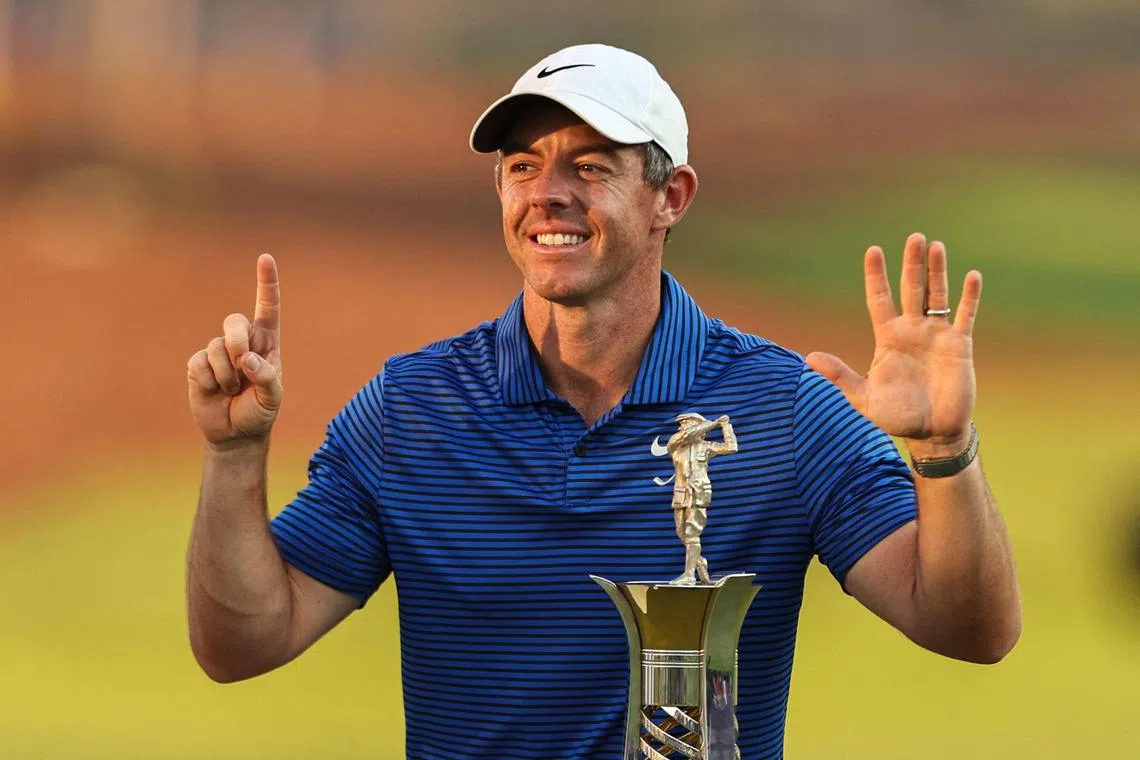Saudi-backed LIV Golf is forcing the PGA Tour to pay players fairly
Sign up now: Get ST's newsletters delivered to your inbox

Northern Ireland's Rory McIlroy and other PGA Tour golfers are independent contractors who are only compensated if they make the cut at a tournament.
PHOTO: AFP
Follow topic:
NEW YORK – The world’s two most prominent professional golf tours have for years battled over players, the moral high ground and outright survival. Now, the feud appears to be ending.
Last week, Bloomberg reported that Saudi Arabia’s Public Investment Fund (PIF), owner of the upstart LIV Golf, is nearing a deal to acquire a 6 per cent stake in the PGA Tour’s commercial arm, PGA Tour Enterprises.
Many fans will find it difficult to accept the two organisations coming together because it will require lovers of the sport to move on from a clash that was often about Saudi Arabia’s abysmal human rights record, not golf.
And as the Gulf state continues to face accusations that it uses sports as a public relations ploy to distract from its troubling reputation, there is another uncomfortable truth to acknowledge.
Without the presence of the Saudis, professional top golfers would have continued to be undervalued by the PGA Tour.
In 2023, the PGA Tour reported US$1.82 billion (S$2.46 billion) in revenue. The money enriches golfers, especially the top ones.
That year, Rory McIlroy earned US$24.9 million in PGA-related compensation. It makes for a great payday, but unlike a National Basketball Association (NBA) player, the four-time Major champion is not a salaried employee.
Instead, he and other PGA Tour golfers are independent contractors who are compensated only if they make the cut at a tournament. And even then, their pay is determined by how high they finish. A top slot is typically worth millions; a bottom finish can be worth the price of a used car.
The PGA does not compensate its players for the value they bring to the sport and its broadcasts.
Comparing it with the NBA, Golden State Warriors superstar Stephen Curry will earn US$53 million in guaranteed money this season. The hefty payout shows that the NBA recognises the value that he brings to the league every time he is on the court.
Contrast Curry’s US$53 million with the US$0 that Tiger Woods earned for missing the cut at the 2024 US Open. He may not be the Tiger of old, but he still draws a lot of viewers to televised golf, and he is objectively worth more.
One main reason is that the PGA Tour has never faced meaningful competition or pressure. Then came the PIF, with nearly US$1 trillion in assets, announcing LIV Golf in 2021.
In LIV’s first year in 2022, every tournament paid a total of US$25 million, and even the last-place golfer was guaranteed to take home US$120,000. Meanwhile, the 2022 PGA Championship had a purse of US$15 million.
But LIV’s biggest innovation was to tilt away from prize money and bring in multi-year, guaranteed deals. Most notably, Jon Rahm received a multi-year contract reportedly worth US$300 million, and even lesser players on the back end of their careers received eight-figure deals.
The move pulled golfers away from the PGA Tour. To survive, it had to pay up. So far, it has.
In 2021, it paid just under US$400 million in prize money; in 2023, it shelled out US$560 million. That year, it also set up a US$100 million pool to reward players who “generate the most positive interest in the tour”.
But the most critical development has been to recognise that the PGA Tour cannot survive if its only tactic is to try to top the guaranteed cash and prizes offered by the deep-pocketed LIV. Instead, it needs to offer something that other professional leagues typically do not – player equity in the league.
Before LIV, the idea might have been dismissed out of hand by the conservative PGA Tour. It likely views player ownership as a threat to its authority. But PIF’s money has changed the risk calculus.
So, the tour created PGA Tour Enterprises in January to manage the league’s commercial activities.
A group of investors led by John Henry’s Fenway Sports Group funded it with US$1.5 billion. Player equity grants worth roughly US$930 million in total will be distributed to players based on their tenure in the tour and their records in its championships. The grants will vest over the years, providing an incentive to stay, win and promote the tour.
It is an idea so full of growth potential that PIF is investing its money into it and settling its grudge. If the tour’s commercial prospects appreciate, as they will, PIF can always sell at a profit.
There are still details to work out and regulatory approvals to receive. But even at this stage, the grants stand as a critical means of ensuring that athlete earnings properly reflect the value they bring to their league and sport.
Players looking to thank someone might want to give a friendly nod to LIV, PIF and Saudi Arabia. BLOOMBERG

